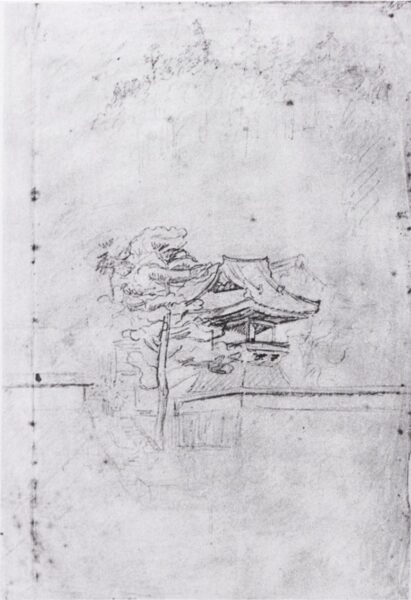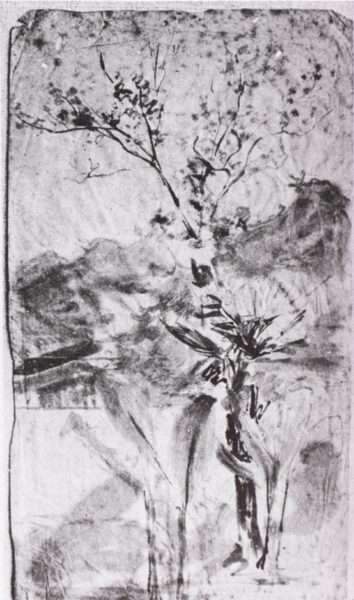The art of Japan is a kind of directly mental expression in physical life. The Japanese use the vital world very little. Their art is extremely mentalised; their life is extremely mentalised. It expresses in detail quite precise mental formations. Only, in the physical, they have spontaneously the sense of beauty. For example, a thing one sees very rarely in Europe but constantly, daily in Japan: very simple people, men of the working class or even peasants go for rest or enjoyment to a place where they can see a beautiful landscape. This gives them a much greater joy than going to play cards or indulging in all sorts of distractions as they do in the countries of Europe. They are seen in groups at times, going on the roads or sometimes taking a train or a tram up to a certain point, then walking to a place from where one gets a beautiful view. Then at this place there is a small house which fits very well into the landscape, there is a kind of small platform on which one can sit: one takes a cup of tea and at the same time sees the landscape. For them, this is the supreme enjoyment; they know nothing more pleasant. One can understand this among artists, educated people, quite learned people, but I am speaking of people of the most ordinary class, poor people who like this better than resting or relaxing at home. This is for them the greatest joy.
Mother in Japan
And in that country, for each season there are known sites. For instance, in autumn leaves become red; they have large numbers of maple-trees (the leaves of the maple turn into all the shades of the most vivid red in autumn, it is absolutely marvellous), so they arrange a place near a temple, for instance, on the top of a hill, and the entire hill is covered with maples. There is a stairway which climbs straight up, almost like a ladder, from the base to the top, and it is so steep that one cannot see what is at the top, one gets the feeling of a ladder rising to the skies — a stone stairway, very well made, rising steeply and seeming to lose itself in the sky — clouds pass, and both the sides of the hill are covered with maples, and these maples have the most magnificent colours you could ever imagine. Well, an artist who goes there will experience an emotion of absolutely exceptional, marvellous beauty. But one sees very small children, families even, with a baby on the shoulder, going there in groups. In autumn they will go there. In springtime they will go elsewhere.
Drawing by Mother during her stay in Japan
There is a garden quite close to Tokyo where irises are grown, a garden with very tiny rivulets, and along the rivulets, irises — irises of all possible colours — and it is arranged according to colour, organised in such a way that on entering one is dazzled, there is a blaze of colour from all these flowers standing upright; and there are heaps and heaps of them, as far as the eye can reach. At another time, just at the beginning of spring (it is a slightly early spring there), there are the first cherry-trees. These cherry-trees never give fruit, they are grown only for the flowers. They range from white to pink, to a rather vivid pink. There are long avenues all bordered with cherry-trees, all pink; they are huge trees which have turned all pink. There are entire mountains covered with these cherry-trees, and on the little rivulets bridges have been built which too are all red: you see these bridges of red lacquer among all these pink flowers and, below, a great river flowing and a mountain which seems to scale the sky, and they go to this place in springtime…. For each season there are flowers and for each flower there are gardens.
And people travel by train as easily as one goes from house to house; they have a small packet like this which they carry; in it they have a change of clothes, that’s quite enough for them; they wear on the feet rope or fibre sandals; when these get worn out they throw them away and take others, for it costs nothing at all. All their life is like that. They have paper handkerchiefs, when they have used them they get rid of them, and so on — they don’t burden themselves with anything. When they go by train, at the station small meals are sold in boxes (it is quite clean, quite neat), small meals in boxes of white wood with little chop-sticks for eating; then, as all this has no value, when one has finished, one puts them aside, doesn’t bother about them or encumber oneself. They live like that. When they have a garden or a park, they plant trees, and they plant them just at the place where, when the tree has grown, it will create a landscape, will fit into a landscape. And as they want the tree to have a particular shape, they trim it, cut it, they manage to give it all the shapes they want. You have trees with fantastic forms; they have cut off the unnecessary branches, fostered others, contrived things as they liked. Then you come to a place and you see a house which seems to be altogether a part of the landscape; it has exactly the right colour, it is made of the right materials; it is not like a blow in your face, as are all those European buildings which spoil the whole landscape. It is just there where it should be, hidden under the trees; then you see a creeper and suddenly a wonderful tree: it is there at the right place, it has the right form. I had everything to learn in Japan. For four years, from an artistic point of view, I lived from wonder to wonder.
And in the cities, a city like Tokyo, for example, which is the biggest city in the world, bigger than London, and which extends far, far (now the houses are modernised, the whole centre of the city is very unpleasant, but when I was there, it was still nice), in the outlying parts of the city, those which are not business quarters, every house has at the most two storeys and a garden — there is always a garden, there are always one or two trees which are quite lovely. And then, if you go for a walk… it is very difficult to find your way in Tokyo; there are no straight streets with houses on either side according to the number, and you lose your way easily. Then you go wandering around — always one wanders at random in that country — you go wandering and all of a sudden you turn the corner of a street and come to a kind of paradise: there are magnificent trees, a temple as beautiful as everything else, you see nothing of the city any longer, no more traffic, no tramways; a corner, a corner of trees with magnificent colours, and it is beautiful, truly beautiful. You do not know how you have reached there, you seem to have come by luck. And then you turn, you seek your way, you wander off again and go elsewhere. And some days later you want to come back to this very place, but it is impossible, it is as though it had disappeared. And this is so frequent, this is so true that such stories are often told in Japan. Their literature is full of fairy-lore. They tell you a story in which the hero comes suddenly to an enchanted place: he sees fairies, he sees marvellous beings, he spends exquisite hours among flowers, music; all is splendid. The next day he is obliged to leave; it is the law of the place, he goes away. He tries to come back, but never does. He can no longer find the place: it was there, it has disappeared!… And everything in this city, in this country, from beginning to end, gives you the impression of impermanence, of the unexpected, the exceptional. You always come across things you did not expect; you want to find them again and they are lost — they have made something else which is equally charming. From the artistic point of view, the point of view of beauty, I don’t think there is a country as beautiful as that.
12 April 1951







